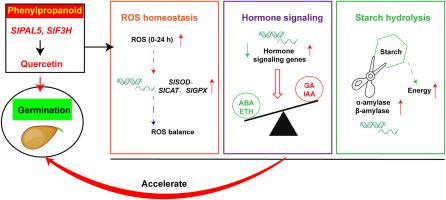Quercetin enhances tomato seed germination via phenylpropanoid-dependent regulation of ROS, hormone signaling, and starch hydrolysis
IF 5.7
2区 生物学
Q1 PLANT SCIENCES
引用次数: 0
Abstract
Seed germination is a critical transition in plant development, tightly regulated by metabolic and signaling networks. The phenylpropanoid pathway is central to diverse plant physiological processes, yet its specific role in seed germination remains poorly understood. RNA sequencing analysis (RNA-seq) revealed that key phenylpropanoid pathway genes are upregulated during germination, particularly SlPAL5 and SlF3H act as the main regulators. Exogenous phenylpropane metabolites associated with SlPAL5 and SlF3H genes, including chalcone, dihydroquercetin, and quercetin, could promote seed germination. Overexpression of SlPAL5 and SlF3H in tomato (SlPAL5-OE and SlF3H-OE) accelerated germination, increased phenylalanine ammonia-lyase (PAL) activity, elevated quercetin accumulation, increased hydrogen peroxide (H2O2) content, and modulated gene expressions linked to reactive oxygen species (ROS) scavenging, phytohormone signaling (ethylene, gibberellins, auxin), and starch hydrolysis. Notably, exogenous quercetin treatment also promoted germination and influenced these transcriptional networks, consistent with the phenotypic outcomes observed in SlPAL5-OE and SlF3H-OE lines. Overall, our results demonstrated quercetin, a central metabolite in phenylpropanoid pathway, enhanced germination by coordinating phenylpropanoid-mediated ROS homeostasis, phytohormone signaling, and starch hydrolysis in tomato. This work provides new insights into phenylpropanoid functions in germination and refines quercetin as proactive regulators for improving tomato seed vigor and agricultural productivity.

槲皮素通过苯丙素依赖性调节活性氧、激素信号和淀粉水解来促进番茄种子萌发
种子萌发是植物发育的关键阶段,受到代谢和信号网络的严格调控。苯丙素途径是多种植物生理过程的中心,但其在种子萌发中的具体作用仍然知之甚少。RNA测序分析(RNA-seq)显示,苯丙素途径的关键基因在萌发过程中表达上调,其中SlPAL5和SlF3H是主要调控基因。与SlPAL5和SlF3H基因相关的外源苯丙烷代谢物,包括查尔酮、二氢槲皮素和槲皮素,可以促进种子萌发。SlPAL5和SlF3H在番茄中的过表达(SlPAL5- oe和SlF3H- oe)加速了萌发,增加了苯丙氨酸解氨酶(PAL)活性,增加了槲皮素积累,增加了过氧化氢(H2O2)含量,并调节了活性氧(ROS)清除、植物激素信号(乙烯、赤霉素、生长素)和淀粉水解相关基因的表达。值得注意的是,外源槲皮素处理也促进了萌发并影响了这些转录网络,这与在SlPAL5-OE和SlF3H-OE系中观察到的表型结果一致。总的来说,我们的研究结果表明,槲皮素是苯丙素途径的中心代谢物,通过协调苯丙素介导的ROS稳态、植物激素信号和淀粉水解来促进番茄萌发。这项工作为苯丙素在萌发中的作用提供了新的见解,并完善了槲皮素作为提高番茄种子活力和农业生产力的主动调节剂。
本文章由计算机程序翻译,如有差异,请以英文原文为准。
求助全文
约1分钟内获得全文
求助全文
来源期刊
CiteScore
11.10
自引率
3.10%
发文量
410
审稿时长
33 days
期刊介绍:
Plant Physiology and Biochemistry publishes original theoretical, experimental and technical contributions in the various fields of plant physiology (biochemistry, physiology, structure, genetics, plant-microbe interactions, etc.) at diverse levels of integration (molecular, subcellular, cellular, organ, whole plant, environmental). Opinions expressed in the journal are the sole responsibility of the authors and publication does not imply the editors'' agreement.
Manuscripts describing molecular-genetic and/or gene expression data that are not integrated with biochemical analysis and/or actual measurements of plant physiological processes are not suitable for PPB. Also "Omics" studies (transcriptomics, proteomics, metabolomics, etc.) reporting descriptive analysis without an element of functional validation assays, will not be considered. Similarly, applied agronomic or phytochemical studies that generate no new, fundamental insights in plant physiological and/or biochemical processes are not suitable for publication in PPB.
Plant Physiology and Biochemistry publishes several types of articles: Reviews, Papers and Short Papers. Articles for Reviews are either invited by the editor or proposed by the authors for the editor''s prior agreement. Reviews should not exceed 40 typewritten pages and Short Papers no more than approximately 8 typewritten pages. The fundamental character of Plant Physiology and Biochemistry remains that of a journal for original results.

 求助内容:
求助内容: 应助结果提醒方式:
应助结果提醒方式:


